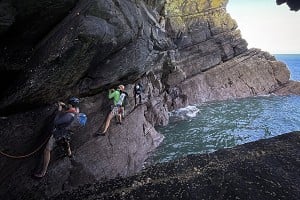
We recently reported that a group of five Aymara indigenous women from Bolivia - known as cholitas escaladoras, the cholita* climbers - had summited Aconcagua (6961m) in the Argentinian Andes. The cholitas started climbing five years ago and set their sights on Aconcagua as their ultimate mountaineering goal, joining an increasing number of cholitas who are pushing to shift perceptions of their capabilities following a long history of social and racial discrimination. One member of the group, Lidia Huayllas Estrada, 53, kindly agreed to a telephone interview about their climb.
In 2014, a group of 11 cholita women decided to do some climbing of their own in addition to their work as cooks and porters for mountaineers on Huayna Potosí (6088m) outside the Bolivian administrative capital, La Paz. The women, ranging from ages 22 to 53, became social media sensations as they were pictured climbing with crampons and ice axes, but still wearing their billowing, brightly coloured traditional skirts (polleras), shawls and bowler hats (borsalinos) with pride.
The short-term goal for the women was to ascend eight peaks above 6000 metres, but their 'ultimate dream' was to climb Aconcagua.
Lidia Huayllas Estrada, Dora Magueño Machaca, Ana Lía Gonzáles Magueño, Cecilia Llusco Alaña and Elena Quispe Tincutas safely summited Aconcagua on 23rd January after spending just over a week on the mountain. Before climbing, the Aymara women perform the challa, a libation ritual performed to honour the Pachamama, or 'mother earth' - an ever-present goddess revered by indigenous groups in the Andes. Their ascent caught the eye of Bolivian President Evo Morales, who congratulated the group and named them 'a pride of Bolivia.' The women also received certificates of recognition from government ministers.
Muy contento por la hazaña alcanzada por nuestras cinco hermanas, conocidas como las "cholitas escaladoras", que lograron llegar a la cima del Aconcagua, el pico más alto del continente. Son un orgullo para #Bolivia 🇧🇴. ¡Muchas felicidades! pic.twitter.com/jSzsbE22zC
— Evo Morales Ayma (@evoespueblo) January 25, 2019
Cholita women are increasingly transcending their traditional roles in domestic service by filling key positions in politics, business and the media, or by participating in typically male-dominated sports such as wrestling and mountaineering. The cholitas luchadoras - or 'fighting cholitas' - have gained similar interest from wider society and international media in recent years. The wrestlers, who perform each Sunday in El Alto in front of a paying audience, were the subject of an award-winning documentary, The Fighting Cholitas, in 2006. Following the election of Morales in 2005 as Bolivia's first Amerindian president, the status of the indigenous population improved through greater representation and recognition. Previously ridiculed for their flamboyant dress, the cholitas have since become models, style icons and TV stars as a more accepting modern generation enabled them to reclaim their cultural identity.
New Zealand climbing instructor Gregg Beisly lived in El Alto from 2009-2015 and recalls an instructor on his team introducing a cholita to ice climbing after she expressed an interest. Fitting a harness over the multiple layers of her skirt was a challenge - much to the amusement of the cholita and her friends. 'The harness was tricky - there's a lot of petticoat under the outer skirt,' Gregg explains. 'It had to go over some layers and under the rest. The next issue was teaching crampon techniques that avoided catching the skirt - no high-stepping was the key!'
The cholita easily ascended an ice line on the Glaciar Viejo on Huayna Potosí, placing her tools well and impressing onlooking locals. Due to their high capacity for physical labour, cholitas tend to be fit and strong. 'She was very pleased with her efforts, particularly since many other people in the group were too worried to even try and others really struggled,' Gregg remembers.
An increase in Aymara pride was evident during Gregg's time in El Alto. 'Since I first climbed there in the 1990's there have been significant positive changes for the community. There is still some discrimination though - some Aymara youth from El Alto tell me they still feel uncomfortable down in La Paz, sometimes being on the end of abusive comments because of their ethnicity.'
This latest feat by the five cholita climbers comes as no great surprise to Gregg. 'I've seen plenty of cholitas in the mountains carrying big loads on rock, snow and ice in their little plastic shoes - so it's not surprising that they are capable,' he explains. 'But in traditional Aymara society, the high mountains are generally avoided or only worked on at most, so that's the interesting aspect. They really are breaking the mold in that respect.' Recreational climbing is relatively new to traditional Aymara areas like El Alto and is almost exclusively carried out by young people. 'It's fantastic to see its reach widening to include cholitas,' Gregg adds.
*The word cholita is derived from the Spanish word "cholo" (chola for females) - meaning mixed-race or, pejoratively, "halfbreed" or "civilised Indian", but in the case of the Aymara women, it has been adopted as a badge of honour.
***
Lidia Huayllas Estrada is 53 years old and lives in El Alto.
(Thanks to Ellen Barber and Sara Medel Jimenez - and her Lower Sixth volunteers at Fettes College, who have been learning about cholita culture - for their assistance with transcription and translation)
Before you started climbing, how was your life as a cholita? What did people expect of you?
Before starting climbing in 2014, I worked in international mountaineers' camps, cooking, cleaning and carrying equipment. I have worked as a cook for about 20 years. Other people did not expect much from me, as I was just a humble cook. Only recently did I gather the courage to climb higher and I think that doors have opened up for me now.
Let's show them with actions, not words."
What did your family think when you started?
My mum really supported me. I no longer have my dad, but my mum has always supported me. She is always giving me words of encouragement. My husband is much the same, he supports me and is also a mountain guide. He is supportive of me and of our children. I have beautiful daughters - two daughters and four grandchildren. My grandchildren also come along with me to the mountains. The little one who is 5 years old has climbed as high as 5130m!
Is there a recreational climbing culture among the indigenous people in Bolivia?
No, not really. There is a climbing culture in my family, but not in the local community. It's a family thing for me.
How did the idea of forming a climbing group for cholitas?
Well, my husband and I first came up with the idea. To be able to do it, we decided that we needed to have a practice day, but we never really had the time. It was not until December 2015 that we discussed it with the cholitas. At first, they really didn't believe me, but I encouraged them and in the end only five of them agreed to climb. That night, word got around - and then we managed to get 11 women to go up Huayna Potosí!
How did other people respond to your idea?
In the beginning, people weren't very accepting. We were also criticised: 'That can't be done by a woman, at least not while wearing the indigenous pollera dress!'; 'Only a man can climb!'; 'It's a man's sport, doing all this work.' I tried to ignore these comments, but my friends were put off by them. They wanted to give up on the idea, but I encouraged them to go ahead. 'Let's show them with actions, not words.' That's how I managed to convince them!
We wanted to see if we were able to achieve this new goal. More for ourselves than anything else. We wanted to know how far we could go!"
Who helped you to train for Huayna Potosí?
Huayna Potosí is the closest mountain to La Paz. Many tourists go there as it is more accessible. Our instructor Olalio Gonzales trained us to achieve this.
Which other mountains did you climb in preparation for Aconcagua?
After Huayna Potosí, we climbed Acotango, Parinacota, Pomarapi, Illimani and Bolivia's highest mountain, Sajama de Oruro (6542m).
Why did you want to climb Aconcagua?
We chose Acongagua because it is the highest mountain in South America and we had already gone as far as 6500m and we wanted to reach 7000m. Aconcagua is actually only 6963m, but after discussing with my climbing group we said: 'Why not dream of Aconcagua?' We weren't in a position to do it either as we had spent a lot of money already, but we wanted to see if we were able to achieve this new goal. More for ourselves than anything else. We wanted to know how far we could go!
How did you train for it?
Well, we had done lots of training, especially in the two months before the climb. We had done long walks, jogging, smaller climbs in the nearby mountains - lots of preparation. The biggest factor was getting used to drinking water. We are not that used to drinking water*, hydration is of course very important but we are simply not used to it (*As in many Andean cultures, the Aymara chew coca leaves and drink coca tea). We had to drink six litres of water a day and this was tough to achieve!
How was the ascent? What challenges did you face?
The ascent was quite straightforward. When we arrived in Mendoza we took it step by step. We had to stop and wait in our tents a lot because the weather forced us to camp. Overall, it took a week and a bit because the weather was not on our side. It was snowing as we arrived and the wind was dreadful...it was awful!
Were you well acclimatised from living and working at altitude?
This is why we drank so much, in order to stay hydrated. The altitude didn't really affect us. I was surprised at the lack of effect that the altitude had on me. I slept so well. I could not believe how well I slept at 6000 metres! Most of my friends were the same.
We have been invited to Chile and Spain (the Pyrenees) and yes, we would still climb in our polleras!"
What about the other women in the group? How did they feel?
We are not all the same age; I am 53, Cecilia is 35 and Anali is 33. The youngest of the group was Elena, at 22 years old. As we were climbing we were all doing quite well, although Dora had a headache and was fatigued, but only for a short while. Anali suffered from nausea and was sick but got better soon after that. The rest of us were doing remarkably well, although when we reached 6000m Cecilia said that her heart was hurting and she shouted 'My heart, my heart!' but after talking and encouraging one another we carried on. There wasn't much more we could do - we were all alone and we had to do it. We had to give each other the strength to go ahead and complete the climb.
How does it feel to be able to climb in your traditional clothes?
Yes, we climb in our traditional clothing; we wear it all the time. It was actually quite helpful because the pollera (skirt) actually kept us warm, we were also wearing a jacket underneath as well as gloves, protective goggles and a cane. We forced ourselves to wear a helmet; here in Bolivia people do not really wear helmets. We didn't really want to wear it, but we had to because everyone said it would be dangerous not to wear one.
Are times changing for cholitas in Bolivia, in your opinion?
Yes, things are changing in Bolivia. Previously, even in offices you had to change out of your traditional wear, especially if you had an important position, but these days you can see cholitas dressed up in offices, behind bank counters and even cholita wrestlers and footballers!
In an interview you said, 'Una mujer no debe quedarse con un sueño, lo debe cumplir.' 'A woman should never be left dreaming, rather she should achieve her dream.' What does this saying mean to you?
We need to be motivated. Yes, I always say that phrase. Age should not be a constraint - if you have dream, go for it! Of course when you are young you don't have those doubts, but especially when you get older you should not be left dreaming, or doubting...just go ahead and do it!
What do other cholitas think of your climbing? Are younger cholitas also becoming interested in climbing?
Yes, I have heard of other groups of younger cholitas organising their own climbs, and I love it, I feel so fortunate to think that I might have inspired them. They will feel free and have a sense of achievement. I am so happy that they might follow in my footsteps.
What's next? Would you like to climb higher peaks in Asia or climb in Europe?
Now my friends and I dream of Everest, we laugh about it, but we dream about it nonetheless!
Yes, I would love to go to the Himalayas, I would love to go to those mountains, but we need funding and training. We have been invited to Chile and Spain (the Pyrenees) and yes, we would still climb in our polleras!
Watch a video about the climbing cholitas below, and find more photos here.
- INTERVIEW: Albert Ok - The Speed Climbing Coach with a Global Athlete Team 17 Apr
- SKILLS: Top 10 Tips for Making the Move from Indoor to Outdoor Bouldering 24 Jan
- ARTICLE: International Mountain Day 2023 - Mountains & Climate Science at COP28 11 Dec, 2023
- ARTICLE: Did Downclimbing Apes help Evolve our Ultra-Mobile Human Arms? 5 Dec, 2023
- ARTICLE: Dàna - Scotland's Wild Places: Scottish Climbing on the BBC 10 Nov, 2023
- INTERVIEW: Loki's Mischief: Leo Houlding on his Return to Mount Asgard 23 Oct, 2023
- INTERVIEW: BMC CEO Paul Davies on GB Climbing 24 Aug, 2023
- ARTICLE: Paris 2024 Olympic Games: Sport Climbing Qualification and Scoring Explainer 26 Jul, 2023
- INTERVIEW: Malcolm Bass on Life after Stroke 8 Jun, 2023
- ARTICLE: Alexandr Zakolodniy - A Climbing Hero of Ukraine 26 Apr, 2023



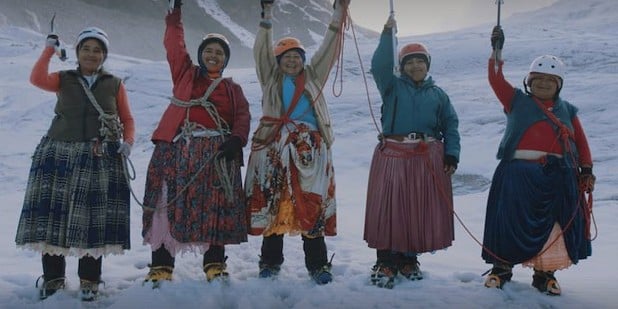
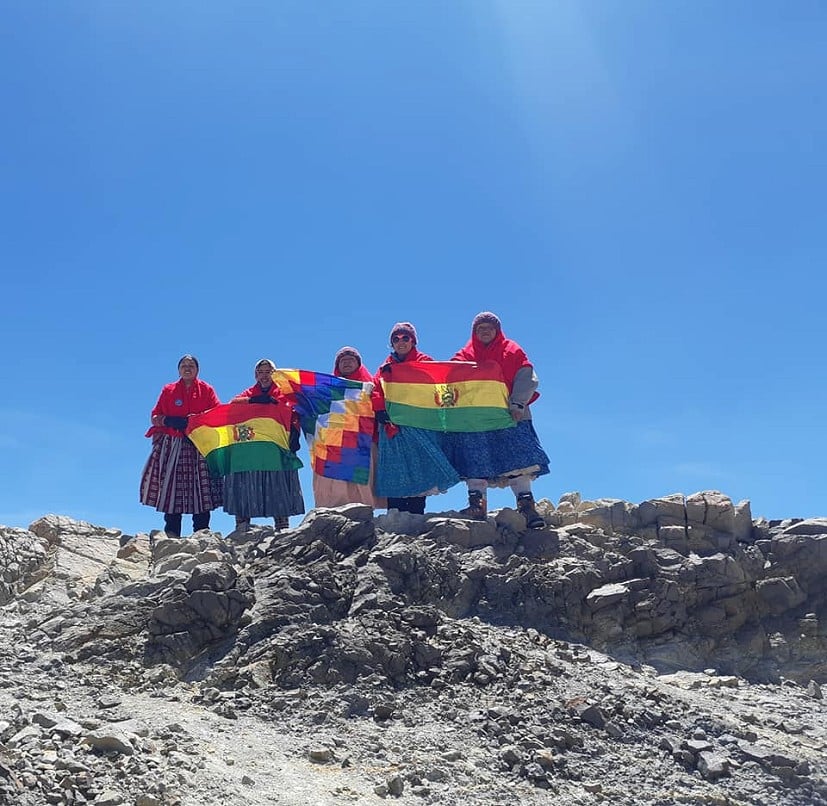
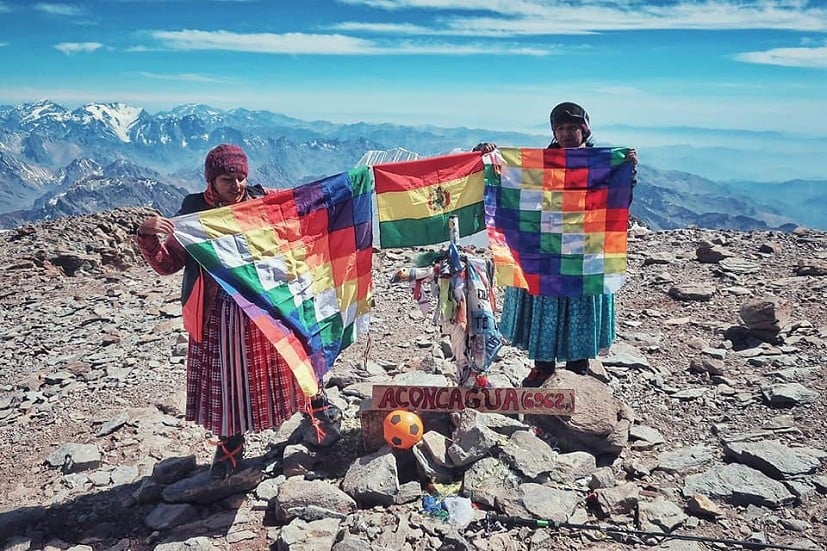

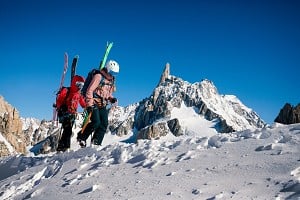
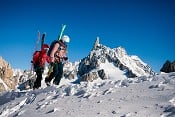
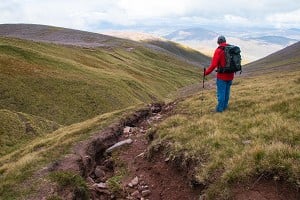
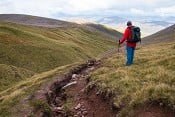


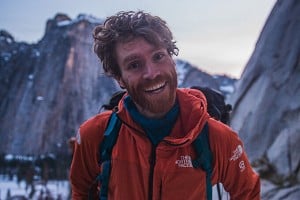
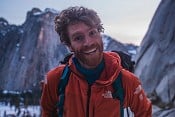




Comments